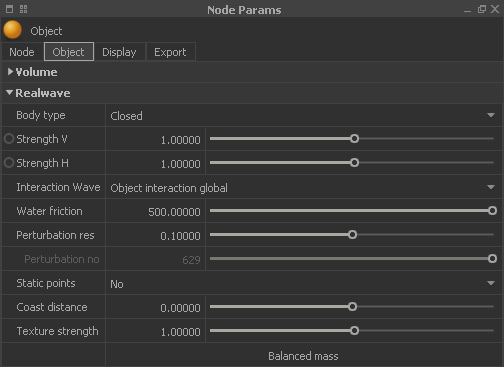Objects - RealWave
This panel is only visible with a RealWave object existing in your scene and is used to control the behaviour of waves, created by an object.
Body type
“Closed” types are actually all 3D objects, such as boats, spheres or characters. “Open” types are thin like tree leaves or sheets of paper.
Strength V
Here you control the vertical displacement of the waves caused by the interacting object. This value should be adjusted in small steps.
Strength H
Here you control the horizontal displacement of the waves caused by the interacting object. This value should be adjusted in small steps.
Interaction Wave
By default, an object is always connected to RealWave’s → “Object interaction global” settings, where the basic interaction between objects and the RealWave surface are defined. If there are further “Object interaction” deformers attached you can select one of them for individual adjustments. Visit → “Wave Object Interaction” for a workflow description.
Water friction
Even water has a certain amount of friction, but it is different from friction that can be observed between solids: in a liquid, the faster something moves through the fluid, the more friction there is.
Perturbation res
If the amount of waves is not enough you can lower this parameter – this way you will get more perturbation points and finally more turbulence.
Perturbation no
This is a read-only value and shows the number of the object's perturbation points. Their number is increased with lower “Perturbation res” values.
Static points
“Static points” are displayed as red vertices and indicate zones without any motion:
- “No” does not use any static points with this object.
- “Inward” is mostly used for obstacles like rocks and objects meant to reflect waves
- “Outward” creates static points around the object. This could be useful for simulating a custom non-rectangular water surface, for example a pond or a puddle.
“Static points” are directly connected to some of the RealWave node’s properties:
- “Autogen static" constantly updates the static points, which is useful for moving objects.
- “Damping factor” must be set to values greater than 0.0 if you want the waves become reflected from the static points.
Coast distance
This parameter creates a circle-shaped area with a gradient around the object. The gradient acts like a shore, where the water becomes more and more shallow. Waves can refract within these zones and generate realistic surface structures. “Coast distance” can only be seen with activated flat shaded mode (9 key). This value is given in metres.
Texture strength
Objects can also contribute to foam-maps. To activate this feature, the RealWave mesh’s → “Calculate texture” option must be set to “Yes” and “Texture strength” to a value greater than 0.0.
Balanced mass
By pressing this button, RealFlow automatically adjusts the correct mass of an → "Active rigid body" (or soft body) to make it swim or float.
